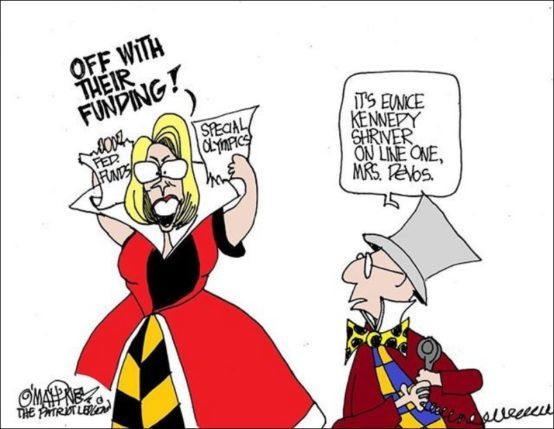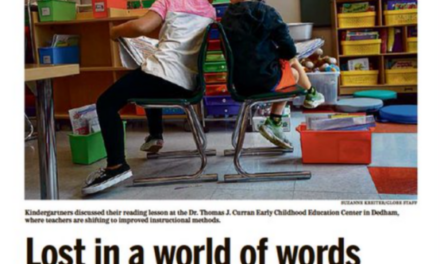How did an obscure ‘non-story’ go viral on social media and dominate last week’s news — and what, if anything, should journalists have done differently in covering the controversy?
By Alexander Russo
For three tumultuous days last week, social media, cable television, and media outlets were obsessed with the Trump administration’s proposal to cut $17.6 million in federal funding for the Special Olympics. It caught nearly everyone by surprise.
The unexpected drama over what was once a small, little-known proposal began on Tuesday with House Democrats grilling Education Secretary Betsy DeVos over the proposed cut, grew louder over the next 48 hours thanks in large part to a firestorm of misleading social media, and pretty much ended Thursday afternoon with a declaration from President Trump that he was reversing his position.
Not unexpectedly, media outlets wrote extensively about the kerfuffle. It was an easy story to tell, pitting the popular program and its many allies against the hapless DeVos. Who doesn’t love public outrage and political theater?
However, some of the coverage amplified the misleading information spread on social media. Too much of it emphasized controversy over substance. And too little of it was up to the task of telling readers where the idea of cutting the funding came from, how the proposal had gotten turned into such a big issue, or why the small program had a larger political importance.
I’m not a DeVos supporter and I’m not particularly in favor of cutting federal funding for the Special Olympics. But we journalists need to get stronger at pushing back against reporting on partisan spectacles and social media outrages. We should be much more explicit about debunking misleading assertions that are going viral, especially when it comes to how we headline stories.
And — most of all — we need to figure out how to give readers more depth and context in the middle of a breaking news situation.
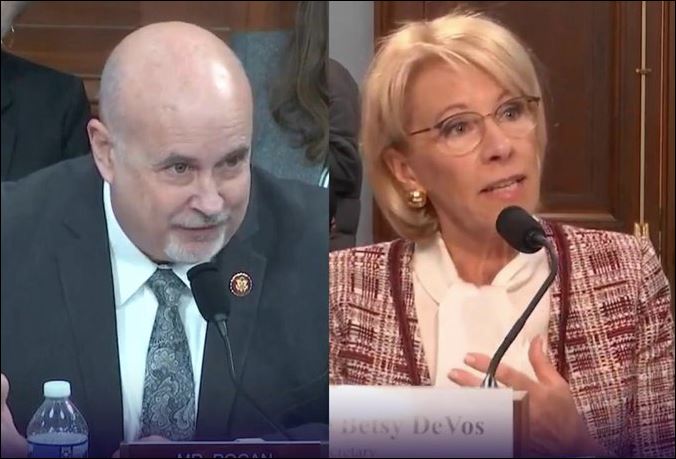
“DeVos didn’t know the number of kids who would be hurt by that [Special Olympics] cut,” tweeted Representative MarkPocan (D-Wisconsin). “So I made sure she now knows that 272,000 kids are seeing their support taken away.”
Three weeks ago, the Trump administration released its budget proposal, an annual document that, once taken seriously, is now routinely ignored by Congress.
This latest proposal included roughly $7 billion in proposed cuts to education, including 29 programs that the administration wanted to zero out. Federal funding for Special Olympics was on that list.
There hadn’t been much indication ahead of time that the proposed cut was going to be a big story. A March 12 story in the New York Times had highlighted the seeming contradiction between White House support for the Special Olympics against proposed cuts to funding it.
But the Trump administration had proposed the cut twice before, and lost, without widespread outrage. The federal contribution was said to represent only about 10 percent of the program’s total budget.
“Never in a million years would I have guessed that Special Olympics funding was going to become such a big story,” EdWeek’s special education reporter Christina Samuels said in a recent phone interview, though she knew that the special education community was deeply suspicious of DeVos.
But then last Tuesday, Secretary DeVos appeared in front of the House of Representatives to defend the administration’s proposal and was grilled by Democratic lawmakers.
In and of itself, the back and forth was nothing new. Members of Congress routinely complain about proposed cuts to programs they favor. Everyone familiar with the process knows that it’s mostly theatrics, with lawmakers trying to score points.
During that House hearing, a somewhat testy exchange between DeVos and House appropriations committee member Mark Pocan (D-WI) over the Special Olympics took place. It was published on Pocan’s Twitter account and several other channels.
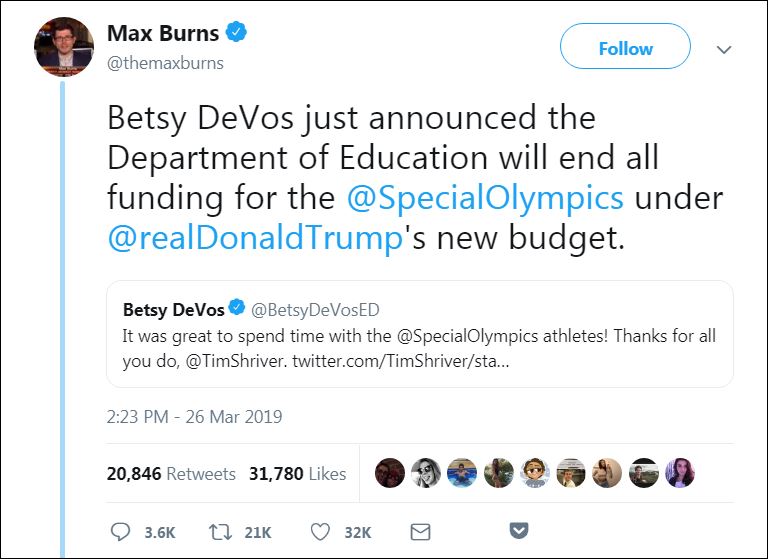
“Betsy DeVos just announced the Department of Education will end all funding for the @SpecialOlympics,” Robert F. Kennedy Human Rights comms director Max Burns tweeted on Tuesday afternoon.
Almost immediately, Special Olympics supporters and big-name opponents of DeVos — think Bernie Sanders and Arne Duncan — began expressing their outrage.
Some of the most viral comments gave the impression that the funding cut was immediate, would decimate the program, and had come from out of the blue.
“Betsy DeVos just announced the Department of Education will end all funding for the @SpecialOlympics,” Robert F. Kennedy Human Rights comms director Max Burns tweeted to his 33,000 followers on Tuesday afternoon, which eventually garnered more than 50,000 reactions.
The story grew quickly on news outlets, too, including both mainstream outlets and trade publications: Trump administration scrambles to defend budget cut for Special Olympics from the Washington Post, DeVos defends proposed Special Olympics cut amid outcry from Politico, and Trump, DeVos bungle Special Olympics budget from The Hill.
Many media outlets made an effort to correct at least some of the inaccurate parts of the story that was being spread. For example, “there’s a long way to go before any program cuts or increases are made final,” wrote EdWeek’s Samuels in an early story headlined Trump Plan to Scrap Special Olympics Funding Draws Fierce Reaction.
But because the cautions and corrections were placed deeper down in the stories, rather than in the headlines, the coverage had the unintended effect of whipping up the frenzy even more.
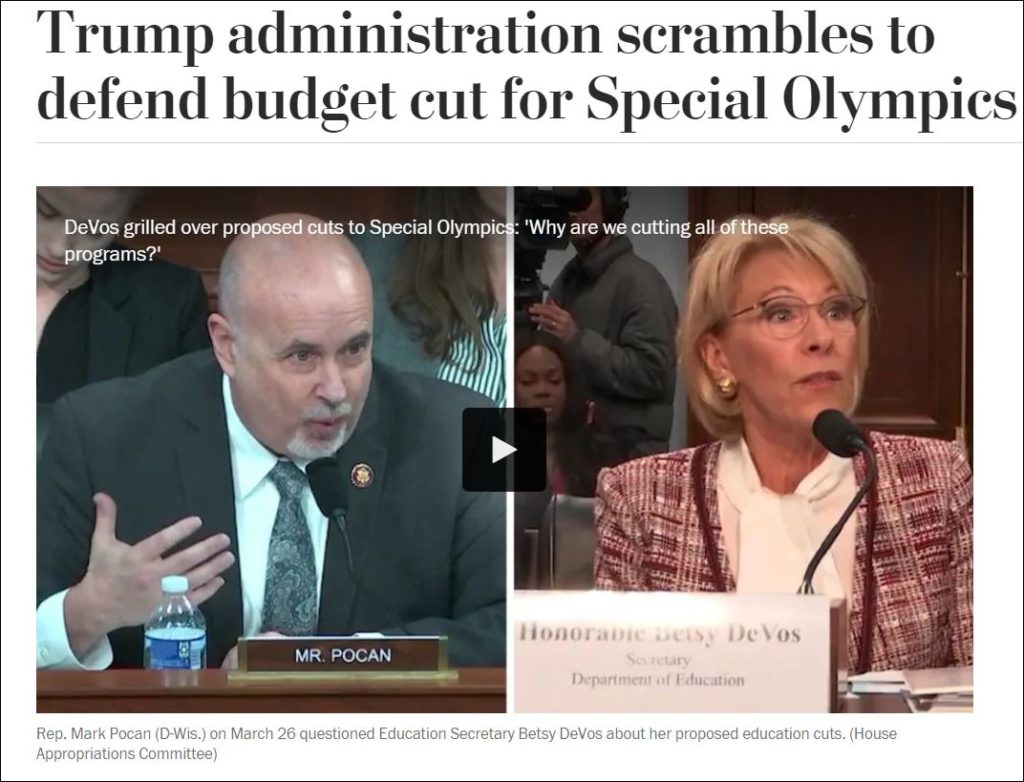
One of several Washington Post stories published last week about the DeVos-Special Olympics controversy.
By the following day, the already slim likelihood of the cut being implemented was diminished further with key House and Senate lawmakers reiterating their opposition to the cut. However, the story wouldn’t die.
DeVos put out a statement slamming “media and some members of Congress” for misrepresenting the facts, which was understandable from her point of view. Since almost the moment she was nominated, media coverage of DeVos has been inordinately bad. But her statement may have given the story added legs. And on Thursday, Senator Dick Durbin (D-IL) and other members of the Senate appropriations committee grilled DeVos about the proposed cut again.
The controversy story just kept getting furthered. It was zombie-like, unstoppable.
Among Washington insiders, it had been clear from the start that the story was being overblown. As the story kept growing and growing, complaints and frustrations grew louder.
“Enough clickbait headlines and articles, please,” tweeted AASA, The School Superintendents Association’s Sasha Pudelski. “Let’s discuss the real funding issues.”
“Can we all stop being angry about this non-story, and instead focus on important things?” tweeted US News education reporter Lauren Smith Camera.
But still, the coverage continued. Maybe Special Olympics funding wasn’t going to be cut, but there were still lots of other ways to keep the story going.
Unfortunately, there seemed to be little if any curiosity in the reporting about how and why the story had blown up so unexpectedly or if anyone was coordinating the effort to push back against DeVos.
Social media can be a source of legitimate news that reporters wouldn’t find any other way, but it is also is continually gamed by advocates and trolls.
“I want to give a shoutout to whatever PR team came up with this pushback campaign, because it’s effective as hell,” former AP reporter and Obama official Dorie Turner Nolt tweeted Thursday afternoon, though she admitted she didn’t have any specific knowledge of who was behind the effort.
Coverage of the Special Olympics controversy tended to treat the social media firestorm as some sort of spontaneous, organic event.
It was only later on Thursday and Friday did broader, more nuanced stories begin to appear.
A HuffPost gave us an overview of how the proposed cuts went “way deeper than the Special Olympics.” A USA Today story revealed that the Bush administration had proposed eliminating federal funding a decade ago. An NYT story reported that the Special Olympics proposal came via acting White House chief of staff, Mick Mulvaney, and the OMB, which had been noted here and there before but never fleshed out. A Washington Post story shed light on the Republican concern that “some of these proposed cuts could emerge as major liabilities on the campaign trail.” And it was finally revealed that DeVos wasn’t behind the cut being proposed, but that she had been overruled by the White House.
But by that time, the damage had been done. The emphasis was still on who had “won” and who had “lost” the debate. How many readers were paying attention to those later stories, anyway?
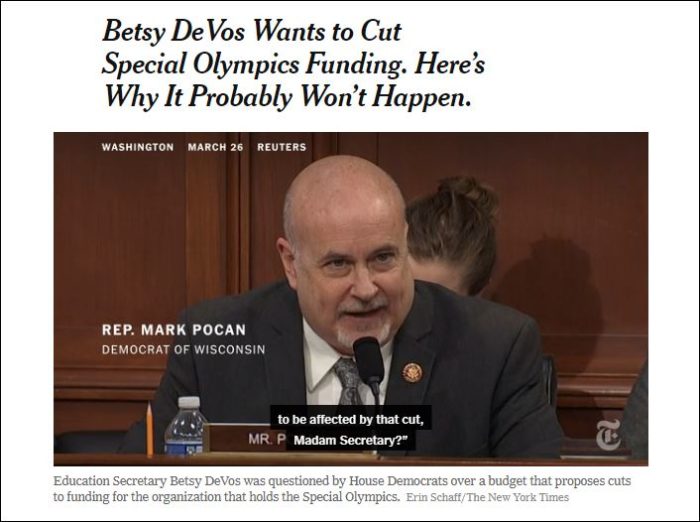
The New York Times (above) and USA Today were among the only media outlets to make the proposal’s slim chances part of the story headline.
While journalists don’t like to talk about it, there’s tremendous competitive and financial pressure on reporters and editors to cover things that everyone else is talking about. “Why don’t we have a story about X?” colleagues and higher-ups ask them.
The Special Olympics controversy was that kind of story: The controversy made it news, even if there was little else about the proposed cut that was being covered beyond the controversy.
For some journalists, the inaccuracies being spread about the proposed cuts were a justification to give the story attention. “If education reporters hadn’t written stories, people would have criticized them for not correcting the record,” tweeted EdWeek’s Evie Blad, whose colleagues (along with many other education reporters) repeatedly pointed out inaccuracies they saw and queried readers about why the miniscule line item was generating so much attention.
Indeed, I and others had criticized reporters for failing to debunk a viral 2017 rumor about DeVos resigning. But in that situation, those very same news outlets weren’t also advancing the DeVos resignation story. They were just watching it passively.
In this case, education reporters were covering the story. And the cautions and clarifications that were provided this time around didn’t make it into headlines where they stood a half a chance of getting anyone’s attention.
The only two stories I saw that prominently debunked the misleading narrative about Special Olympics funding being endangered were Wednesday’s New York Times story headlined DeVos Wants to Cut Special Olympics Funding. Here’s Why It Probably Won’t Happen and Thursday afternoon’s USA Today story, Special Olympics: Why proposed budget cuts are unlikely to happen.
Others may argue that there’s not really all that much they can do to knock down misleading stories when they go viral, or that it’s not the media’s job to tell one side’s story, even if it’s being drowned out. But that’s not my viewpoint.
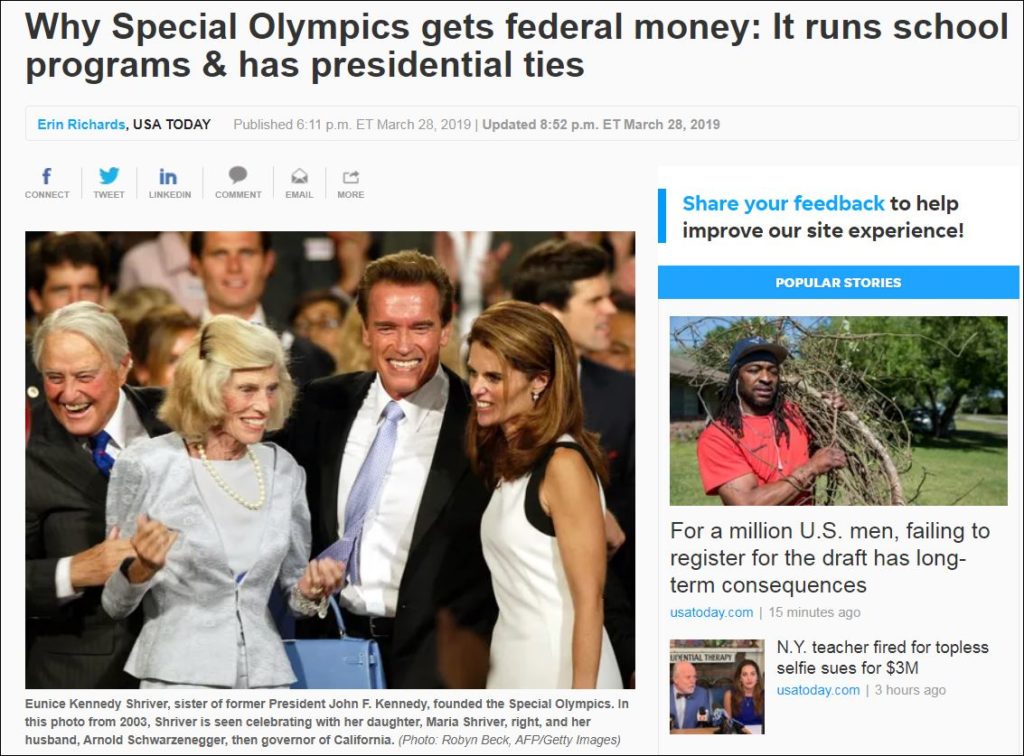
A Thursday story from USA Today helped give context to the controversy over proposing to cut federal funding for the Special Olympics.
Something like last week’s Special Olympics controversy is almost certain to happen again — probably very soon. We need to come up with a better game plan for covering it.
The main thing is for reporters to stop being surprised when these kinds of non-stories pop up out of events that seem ho-hum, EdWeek’s Samuels said.
“These firestorms can come up at any time,” she told me, especially when DeVos is involved. “It’s time to stop being surprised.”
Towards that end, I’ve put together a preliminary crib sheet for education reporters covering social media firestorms, inspired by the “On The Media” crib sheet for breaking news.
Ask yourself these questions and really consider the type of story you want readers to read:
1 – Be prepared, no matter how mundane the situation seems to be. If DeVos is involved, there’s a 50-50 chance something could happen.
2 – Question everything you see and hear — especially if it’s making everyone really mad. Does the video snippet match the description? Are the assertions being made factual?
3 – Find out where the outrage is coming from. There’s usually one or two “ground zero” social media accounts or posts. Who’s behind the story, and have they tried to revise or amend their initial comments?
4 – Give readers the backstory as much as you give them the spectacle and the outrage. Has this happened before, and with what result? Who are the main players behind the scenes? What if any real-world consequences are involved?
5 – Knock down false information in your story and blog post headlines, as well as on Twitter and in your stories. Headlines are all most folks are going to see.
6 – Push back against editors and colleagues whose FOMO is getting the best of them. You don’t have to write the same story everyone else is writing, especially if you don’t have any useful original reporting to add.
We may need a crib sheet like this sooner than later. Rumors about DeVos’s resignation are already swirling again.
Previous columns:
A year full of terrible, horrible, no good, VERY bad media coverage of Betsy DeVos (January 2018)
How the DeVos resignation rumor went viral – and what to do next time (November 2017)
‘No access’ to Betsy DeVos? No problem (June 2017)
Why DeVos Commencement Coverage Was So Basic (May 2017)
DeVos Confirmation: The Cliffhanger That Wasn’t (February 2017)
Covering DeVos (January 2017)
ABOUT THE AUTHOR

Alexander Russo
Alexander Russo is founder and editor of The Grade, an award-winning effort to help improve media coverage of education issues. He’s also a Spencer Education Journalism Fellowship winner and a book author. You can reach him at @alexanderrusso.
Visit their website at: https://the-grade.org/

